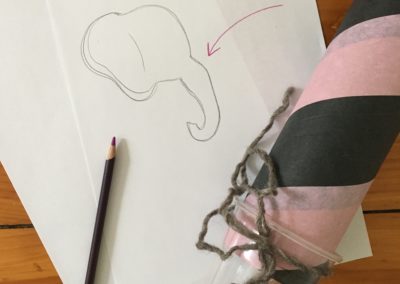Features to Sounds
Developed by Abbey Kaknes, PCM Play Intensive 2021
(FOCUS: Grade 2, Science, Creativity & Making, Design Thinking)
All animals make different kinds of sound. All animals have different and unique characteristics that produce different kinds of sound. How do animals use their unique features or characteristics to make sound?
We have been learning about how animals use sound what specific features or characteristics animals have to make sound.
Today you will use the specific features or characteristics of animals that make sound to invent your own animal feature or characteristic that creates sound.
Materials
- String
- Tape
- Recycled Materials (cardboard, yogurt cups, milk cartons, wine corks)
- Hole Puncher
- Scissors
- Permanent Markers
- Paper
Set Up
Products should be sorted and organized so it is clear what products can be used.
Students work independently on their own creations, but should be arranged in groups so they can inspire each other.
Student’s Job
Think about the different features or characteristics that animals have to make sound. How do animals use their unique features or characteristics to make sound? Using this as inspiration, what can you make that would replicate a feature or characteristic and the sound it makes? You can use your imagination and invent your own animal feature or characteristic!
- Select the materials you will need (recycled materials, tape, string)
- Construct and test out your creation
- Be prepared to share your creation with the class
Further Challenges:
This lesson can be repeated a second, third, or fourth time. Students can build on their knowledge and understand of how the materials make sound. This will give students an opportunity to learn from what worked and what didn’t work.
- Create an interactive class book/play that incorporates all creations of sounds.
- Create a class video of play
Teacher’s Job
Standards Alignment
COMMON CORE STATE STANDARDS.ELA-LITERACY.READING: INFORMATIONAL TEXT.2.2
IDENTIFY THE MAIN TOPIC OF A MULTIPARAGRAPH TEXT AS WELL AS THE FOCUS OF SPECIFIC PARAGRAPHS WITHIN THE TEXT.
COMMON CORE STATE STANDARDS.ELA-LITERACY.READING: INFORMATIONAL TEXT.2.3
DESCRIBE THE CONNECTION BETWEEN A SERIES OF HISTORICAL EVENTS, SCIENTIFIC IDEAS OR CONCEPTS, OR STEPS IN TECHNICAL PROCEDURES IN A TEXT.
NEXT GENERATION SCIENCE STANDARDS: WAVES & THEIR APPLICATION IN TECHNOLOGIES 1-PS4-4
USE TOOLS AND MATERIALS TO DESIGN AND BUILD A DEVICE THAT USES LIGHT OR SOUND TO SOLVE THE PROBLEM OF COMMUNICATING OVER A DISTANCE.
Connections to Previous Work?
How can we use sound and light to communicate messages?
- Vibrating materials make sound. Sound makes materials vibrate.
- Materials interact with light in different ways.
- Light and sound travel
- Humans and other animals communicate with light and sound.
- People innovate and invent to solve problems.
Prepare/ Background Info
Read aloud Amazing Light by Sally Hewitt to your class.
Facilitation Strategies
Guide a whole class discussion with the following questions:
What specific features to animals have to make sound? How do animals use sound? What is it about the features or characteristics that makes sound? What are the different sounds that animals make? Do you see notice anything that is the same or different with the different sounds that animals make?
Play to Notice
What kind of sounds are children naturally drawn to? Do children enjoy the constructing of instruments or the product of sound more?
Content Matter to Notice
Are children transferring the academic vocabulary in their informal conversations/dialogue?
Vocabulary to Notice: Senses, vibrations, listen, loud, quiet, voice boxes, waves, echoes, instruments, notes, wires, radios.
SEL to Notice
Are children able to problem-solve independently when they are stuck or their idea does not turn out as intended?
Are children able to use their curiosity to take risks and try out an idea?




0 Comments